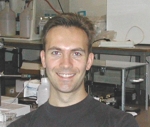
INFM Natl. Center - S3, University of Modena and Reggio Emilia, Via Campi 213A, I-41100 Modena, Italy, and
e-mail: berti.lorenzo@unimore.it

 |
Lorenzo Berti, Andrea Alesandrini, and Paolo Facci
INFM Natl. Center - S3, University of Modena and Reggio Emilia, Via Campi 213A, I-41100 Modena, Italy, and e-mail: berti.lorenzo@unimore.it |
 |
DNA self-assembly is widely recognized as one of the most promising tools for bottom-up construction of nanodevices. Besides assisting in the positioning of nanocomponents, conductive nanowires can be formed by DNA-templated silver deposition. By this procedure, pre-formed DNA:Ag+ complexes are reduced, forming silver clusters along the DNA chain. Subsequent electroless metal deposition joins the clusters, resulting in a conductive wire. It is known that Ag+ forms complexes through coordination with the DNA bases. By modulating the DNA:Ag+ complex formation, we will generate DNA stretches where silver deposition is impaired (or promoted), forming nanometric insulated gaps. Different strategies will be presented for guiding the formation of the clusters precursors: a) introduction of abasic nucleotides stretches; b) pre-treatment of selected sequences with a reducing agent (selective sensitization); c) pre-treatment of selected sequences with a blocking agent (selective de-sensitization). Sensitized and de-sensitized stretches will be ligated, resulting in an imprinted template for patterned silver deposition.
Besides being insulated, the gaps obtained will be further functionalized through introduction of a biotin or thiol moiety, to demonstrate the precise positioning of streptavidin or other thiol reactive molecule. In this presentation we will report our progress towards this goal.